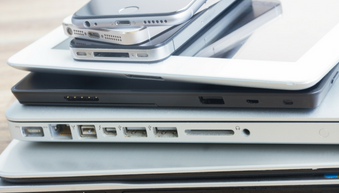 Even if you've never heard the term "Internet of Things" or its more-often-used abbreviation "IoT," you've probably thought of it. You've definitely used it. And you've probably been frustrated by it. Maybe, even, you can't live without it.
Even if you've never heard the term "Internet of Things" or its more-often-used abbreviation "IoT," you've probably thought of it. You've definitely used it. And you've probably been frustrated by it. Maybe, even, you can't live without it.
IoT, the Internet of Things, is a collective term for all those "things" in our lives that connect us to the Internet. It's not just laptops, mobile phones and TVs. The IoT now also includes refrigerators, thermostats, lamps, home security systems, children's toys, cars, cameras, coffee makers, printers, door locks, sprinklers, GPS-enabled dog collars, baby monitors...
The list of IoT-connected everyday objects is incredible, and growing every day. Basically, if it connects us to the Internet, or connects to something else that connects to the internet, and you can turn that connection off or on, it's part of the IoT.
But how is this a bad thing...we LOVE our devices!
It's a fact that these "smart devices" make our lives infinitely easier and more efficient. Our mobile phone alarm tells us to wake up. Our coffee pot is programmed to have a steaming cup ready and waiting when we drag ourselves into the kitchen. We ask our Echo what the weather will bring today so we know how to dress. We strap on our fitness tracker to get alerts when it's time to exercise. Our cars tell us how to get where we're going, alert us when a vehicle two cars ahead is slowing down, start our wipers automatically when it rains, and play only our favorite music. We can even pull up a picture of the inside of our refrigerator to see what we need to buy when we get to the grocery store.
You get it. It's been easy enough to adapt our lifestyles to these automated conveniences, even for the staunchest technophobes. Maybe it's to the point that we don't even realize how connected we are...
Until it's too late.
Queue the conspiracy theories. The advent of the "rise of the machines." Stories about "Big Brother" watching us in our most private moments and tracking our every move.
The risks of the IoT
Despite the dramatic italics, the risks arising from our use of the IoT do not comprise a conspiracy theory or Orwellian tale of government or corporate control. The creators and providers of these devices - or the IoT itself - are not the ones we should fear.
It's the bad guys. The criminals who are always looking for an easy way to take what isn't theirs. These crooks have computer skills, and they're using their powers for evil. As with all new things, there will be ones who will try to exploit every aspect of the IoT, making the very conveniences that we enjoy things we should consider with caution.
Every day cyber criminals are finding new vulnerabilities to exploit. They're getting access to our devices en masse and using this power to take down websites and computer networks via large-scale DDoS (distributed denial-of-service) attacks. They're also gathering information they can use to send spam emails, steal our personal information, monitor our comings-and-goings or simply shut down our devices.
The threat is real, and National Cyber Security Awareness Month is a great opportunity for entities like the Federal Bureau of Investigation to educate us - the consumers and end-users of the "things" in the IoT - of the vulnerabilities and risks we face...and more importantly, how to protect ourselves against becoming a victim.
Being #cyberaware within the IoT
The first step to IoT cyberawareness is the realization of how many connections we truly have to the Internet. How many devices mentioned so far are "on" in your home, car or office right now?
Once you've identified all of these devices, you can start taking preventive measures, like:
- Change any "default" usernames and passwords to a stronger, difficult-to-guess version. This includes the router or device you're using to provide Internet service to these things.
- Consider if you really need all of these devices to be connected and/or turn them off when not in use.
- Learn more about your devices and their manufacturers, read the device's recommended security practices, and confirm that the company is reputable...and still in business.
- Always take advantage of software updates and security patches issued by the manufacturers of these devices. It may be that they created a patch to fix a vulnerability uncovered by a cybercrook.
- Observe best practices when connecting to public wireless networks, and always look for the "https://" website address prefix and or the padlock emblem and the word "Secure" in the URL window before providing confidential information via a device.
Cybersecurity is a top priority here at Bank Independent, and a big part of our mission is to educate you, our customers and neighbors, about new threats and what we can do to keep ourselves and our devices safe. If you've missed some of our previous blogs on the topic, you can catch up with these:
- 10 Ways to Foil Cyberfraudsters
- 12 Ways to Protect Your Mobile Device
- Business Owners: Beware of Ransomware
- Tips to Avoid Online Fraud During the Holidays
- October Is National Cybersecurity Awareness Month
October isn't the only time we should be aware of cybersecurity risks and best practices, but it's a great time to start! Visit the official National Cyber Security Awareness Month website, staysafeonline.org, to register as a NCSAM Champion (like Bank Independent did!) and get involved.
The more #cyberaware you are, the more #cyberprepared you can be.
